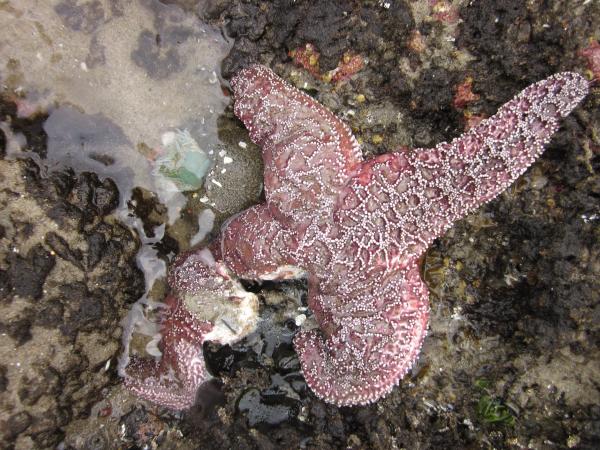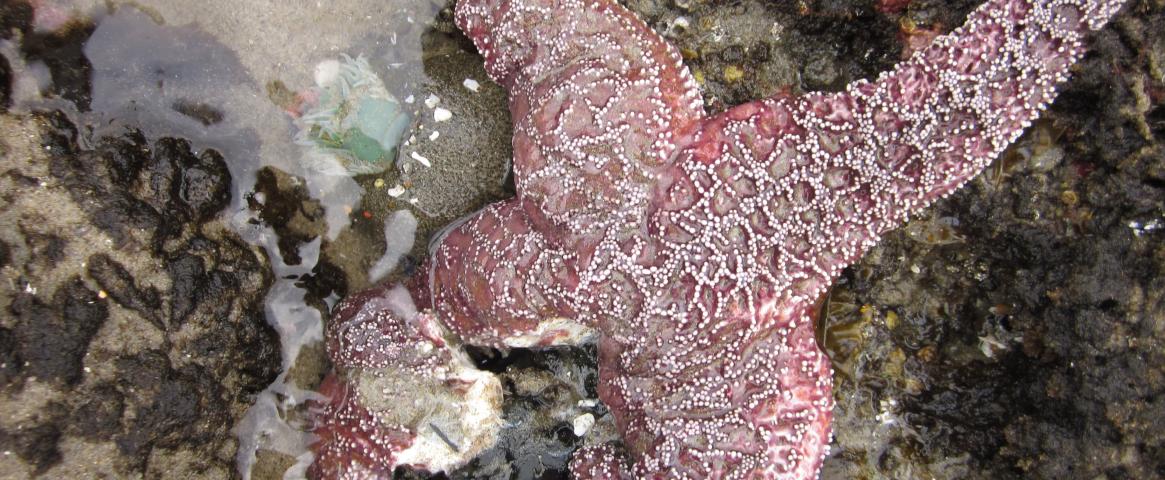By Kori Suzuki
Climate change is driving marine disease outbreaks: NASW Travel fellow Kori Suzuki brings us the story from the AAAS Meeting in Seattle.

SEATTLE — Drew Harvell walked down the beach in the dark. In the glow of her headlamp, hundreds of sea stars were dying.
The colorful marine invertebrates were falling apart. Some were in the process of breaking into pieces, their internal organs spilling out onto the rocks. Arms were scattered across the beach.
Harvell was horrified.
“It was like a bomb went off on the beach,” she said.
The sea stars were infected with wasting syndrome — a mysterious, fast-acting disease that causes tissue decay and can eventually result in disintegration and death of infected starfish. The biological cause of the disease is still unknown. But Harvell, a professor of ecology and evolutionary biology at Cornell University, says climate change is a major factor driving the outbreak. She presented her research at this year’s annual meeting of the American Association for the Advancement of Sciences in Seattle on Feb. 15.
Human-caused climate change is increasing ocean temperatures worldwide. Burning fossil fuels like gasoline produces greenhouse gases that trap heat in the atmosphere. A lot of that extra heat is absorbed by the oceans. In September, a major United Nations report described underwater heat waves sweeping across the planet as a result of climate change. Now, researchers say those heat spikes are fueling disease outbreaks in keystone marine species like sea stars.
Sea stars live in kelp forests, which are home to thousands of fish and other species, including sea urchins. Sea stars eat the sea urchins, and urchins eat the kelp. But between 2013 and 2014, huge outbreaks of sea star wasting syndrome led to mass die-offs of the creatures. Without the stars to keep sea urchins in check, urchin populations have exploded, causing catastrophic declines in kelp beds.
Warming waters also pose a danger to other species like wild Chinook salmon, which are listed as federally endangered in California, Washington and British Columbia.
Wild salmon are a big part of natural and human cycles in the Pacific Northwest. As they migrate from the ocean back to the rivers where they lay their eggs, the fish feed dozens of other animals like grizzly bears. Salmon are also a key cultural resource for Native American tribes in the Pacific Northwest and a major part of the $3 billion Pacific fishing industry.
Kristi Miller, head of molecular genetics at Fisheries and Oceans Canada, says that unusually warm waters cause stress in salmon, which makes them less prepared to fight off disease. At the same time, many infections spread faster at higher temperatures. Miller says these different stressors work together to fuel the spread of a disease.
“The presence of two or more stressors can actually create a much stronger negative impact on the host or the organism,” Miller said.
That means disease outbreaks can be much worse in areas where marine temperatures are rising. In some cases, Miller’s research found that a temperature increase of less than 5 degrees Fahrenheit meant a 60% increase in the presence of an infection.
Her group has developed a new tool to map these diseases and stressors. When a salmon experiences something like higher-than-normal temperatures, that stress causes a unique series of genes to activate, making proteins to respond to the environmental change. When that salmon experiences a different stressor like saltier water, that activates a different genetic response.
Miller and her team can read those signs by taking a small genetic sample from the fish’s gills. That allows them to accurately map stressors in the field by determining where those stressors are affecting individual salmon. “The reason that that's important is we can't control and mitigate everything,” Miller said. Even if researchers can’t control the cause of a disease, they might be able to slow or even stop it by controlling the other stressors that help it to spread. For wild salmon, mitigating the disease-driving factors that are controllable could make the difference between extinction and a sustainable population.
Kori Suzuki is an award-winning multimedia journalism student and a junior at Macalester College in Saint Paul, Minnesota. He covers climate science, environmental policy and human rights. He reported and produced this story as a travel fellow with the National Association of Science Writers. See more of his work at korisuzuki.com or follow him on Twitter @korisuzuk1



